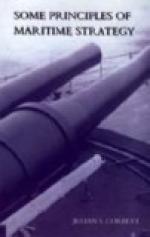These considerations lead us directly to the paradox which underlies the unbroken failure of our enemies to exercise decisive pressure upon us by operations against our trade. It is that where attack is most to be feared, there defence is easiest. A plan of war which has the destruction of trade for its primary object implies in the party using it an inferiority at sea. Had he superiority, his object would be to convert that superiority to a working command by battle or blockade. Except, therefore, in the rare cases where the opposed forces are equal, we must assume that the belligerent who makes commerce destruction his primary object will have to deal with a superior fleet. Now, it is true that the difficulty of defending trade lies mainly in the extent of sea it covers. But, on the other hand, the areas in which it tends to congregate, and in which alone it is seriously vulnerable, are few and narrow, and can be easily occupied if we are in superior force. Beyond those areas effective occupation is impossible, but so also is effective attack. Hence the controlling fact of war on commerce, that facility of attack means facility of defence.
Beside this fundamental principle we must place another that is scarcely less important. Owing to the general common nature of sea communications, attack and defence of trade are so intimately connected that the one operation is almost indistinguishable from the other. Both ideas are satisfied by occupying the common communications. The strongest form of attack is the occupation of the enemy’s terminals, and the establishment of a commercial blockade of the ports they contain. But as this operation usually requires the blockade of an adjacent naval port, it also constitutes, as a rule, a defensive disposition for our own trade, even when the enemy’s terminal area does not overlap one of our own. In the occupation of focal areas the two ideas are even more inseparable, since most, if not all, such areas are on lines of communication that are common. It will suffice, therefore, to deal with the general aspect of the subject from the point of view of defence.
It was in conformity with the distinction between fertile and infertile areas that our old system of trade defence was developed. Broadly speaking, that system was to hold the terminals in strength, and in important cases the focal points as well. By means of a battle-squadron with a full complement of cruisers they were constituted defended areas, or “tracts” as the old term was, and the trade was regarded as safe when it entered them. The intervening trade-routes were left as a rule undefended. Thus our home terminals were held by two battle-squadrons, the Western Squadron at the mouth of the Channel, and the North Sea or Eastern Squadron with its headquarters usually in the Downs. To these was added a cruiser squadron on the Irish station based at Cork, which was sometimes subordinate to the Western Squadron




